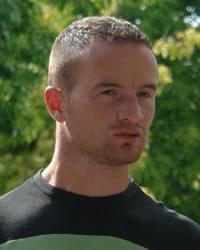The Macedonians are a southern Slavic people and speak the Macedonian language which is a part of the South Slavic group of languages. The modern Macedonians developed as a result of the mixing of the Slavs that came on the Balkans in 6th AD century, with local peoples that were living in North Macedonia prior to their coming. By absorbing the peoples living in North Macedonia, the Slavs also absorbed their culture, and in that amalgamation a people was gradually formed with predominantly Slavic ethnic elements, speaking a Slavic language and with a Slavic-Byzantine culture.
In 581 AD, on the territory of Macedonia, the Slavs created their own country-like formation called the Macedonian Sclavinia, which waged several wars against the Byzantine Empire. In 686 AD, the last Macedonian Sclavinia was occupied by the Byzantium and the Bulgarians. In the 8th century, the Macedonian Slavs under Byzantine rule were baptized and accepted Christianity, and the Macedonians under Bulgarian rule became Christians in the 9th century. The Macedonians have a great role in the creation of Slavic writing. The local dialect of the Macedonian Slavs spoken north of Thessaloniki became the basis for Old Church Slavonic, the first literary Slavic language. During the whole medieval period, Macedonia was constantly an object of conquest and was being slipped from Byzantine to Bulgaria to Serbia. This ended in the 14th century when Macedonia, together with the whole Balkan region, was conquered by the Ottoman Turks.
Because of the fact that the Macedonians did not have their own statehood during the medieval period, they did not have any developed national identity. They only referred to themselves as Macedonian Christians, and this was how they identified themselves. But after the creation of the Greek, Bulgarian and Serbian states gained independence from Turkey, the three young countries started opening Greek, Bulgarian and Serbian churches and propagandist schools in order through education to assimilate the Macedonian population. From 1878 till 1912, Bulgaria, Greece and Serbia, through their educational and church institutions, struggled for the hearts and minds of the Macedonians. The rival propagandas succeeded in dividing the Macedonians into three distinct parties, the pro-Bulgarian (which was the largest), pro-Greek and pro-Serbian one, at the expense of the development of a unique Macedonian identity.
In the period between 1903 and 1908 the three Balkan countries started arming the three different parties and stimulating them to fight one another. This period of the history of Macedonia is called the Macedonian Struggle and is manifested with a brother killing his own brother for being a partisan of the different nationalist propaganda. This period lasted till 1912, when Macedonia was divided between Greece, Bulgaria and Serbia.
In those dark days the National Awakening of the Macedonians took place. In late 19th and early 20th century several Macedonian intellectuals living abroad propagated the idea of the unique character of the Macedonians, that is, that the Slavic-speakers of Macedonia compose a separate ethnicity which is different from Serbian, Bulgarian and Greek.
After the Balkan Wars, following division of the region of Macedonia amongst the Kingdom of Greece, the Kingdom of Bulgaria and the Kingdom of Serbia, and after WWI, the idea of belonging to a separate Macedonian nation was further spread among the Macedonians. The suffering during the wars, the endless struggle of the Balkan monarchies on dominance over the population made the Macedonians more and more aware that the creation of an independent Macedonian state and a development of a Macedonian nation would put an end of their suffering.
The first revolutionary organization that promoted the existence of a separate ethnic Macedonian nation was IMRO (United), which was created in 1925 and was composed of Macedonians with leftist ideology. This idea was internationalized and backed by the Comintern which issued in 1934 a declaration supporting the further development of the Macedonian nation. This action was backed by the Bulgarian, Greek and Yugoslav communist parties and they started supporting the national consolidation of the Macedonian people and created Macedonian sections within the parties, headed by a prominent IMRO (United) member.
In World War II, Macedonia was occupied by Italian, German and Bulgarian troops. In mid-1941, the first Macedonian partisan units were created and organized attacks on targets in the cities of Kumanovo and Prilep. The first greater partisan battalion was formed in 1943, and in the same year, the armed struggle against the fascist occupation was conducted in every part of Macedonia. On August 2, 1944, the ASNOM (Anti-Fascist Assembly of the National Liberation of Macedonia) was held on which the decisions were made for the establishment of the Macedonian State as a federal unit within the framework of the Yugoslav Federation and the officializing of the Macedonian language. During the period September November 1944, the Macedonian Partisan Army took the final offensives, which resulted in the liberation of the whole of the territory of Vardar Macedonia.
After being nearly 50 years a federal republic in Yugoslavia, on 8 September 1991 Macedonia proclaimed its independence. From 1991 till today, North Macedonia has been hoping to turn their allegiance to the West.
In Albania, Macedonians have the right to primary education in their mother tongue but have problems with economic issues.
Macedonians in Albania have a number of media outlets in their language. They have Macedonian-language radio, newspapers and television stations.
The vast majority of the Macedonians are East-Orthodox Christians, but there are also some Muslim Macedonians and some Macedonians that practice Catholicism and Protestantism. In the 21st century, they began to build new Macedonian Orthodox Churches.
The strategic goals of North Macedonia and the Macedonian people are a stable political system, a strong economy, respect for the rights of the Macedonian minorities in neighboring countries, and membership in NATO and the European Union.
Pray for a Jesus-oriented revival among Macedonians that will turn their hearts to the only savior.
Pray that soon Macedonian disciples will be making more disciples.
Scripture Prayers for the Macedonian in Albania.
https://en.wikipedia.org/wiki/Macedonians_in_Albania
| Profile Source: Joshua Project |










